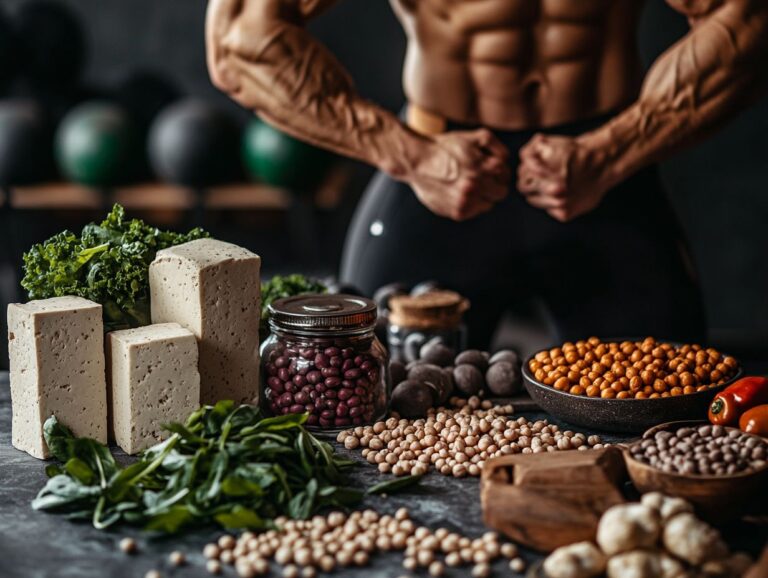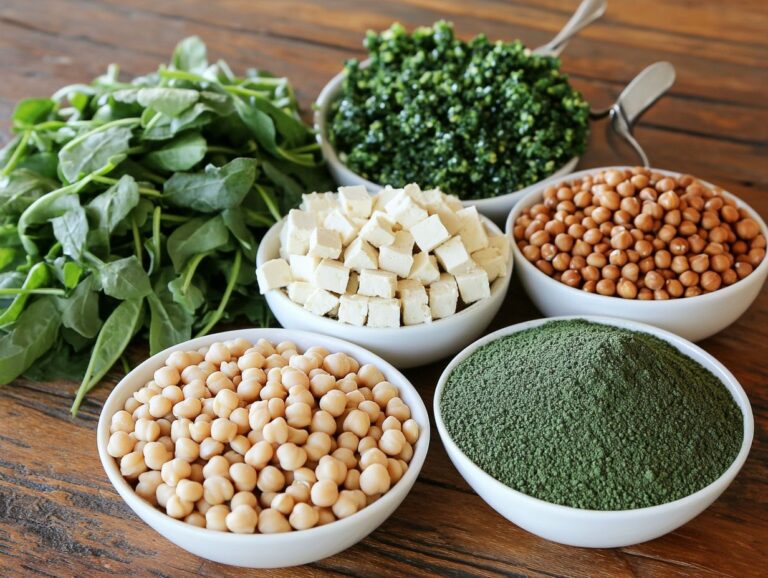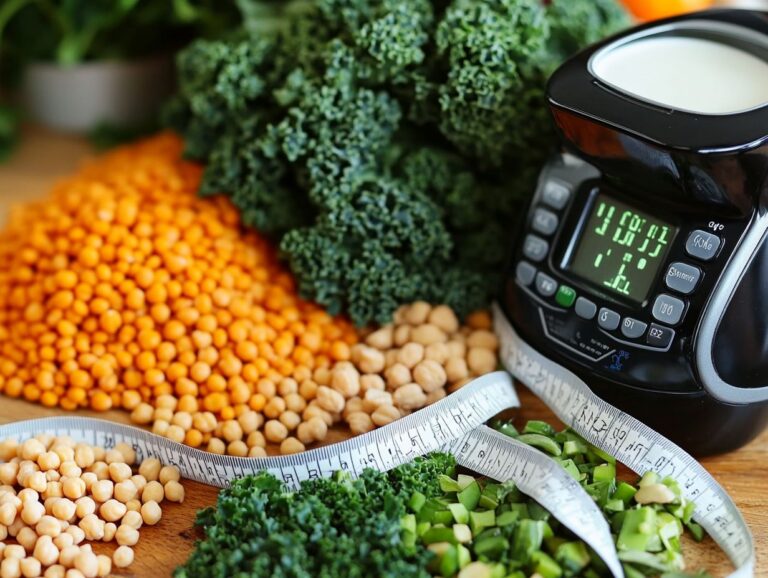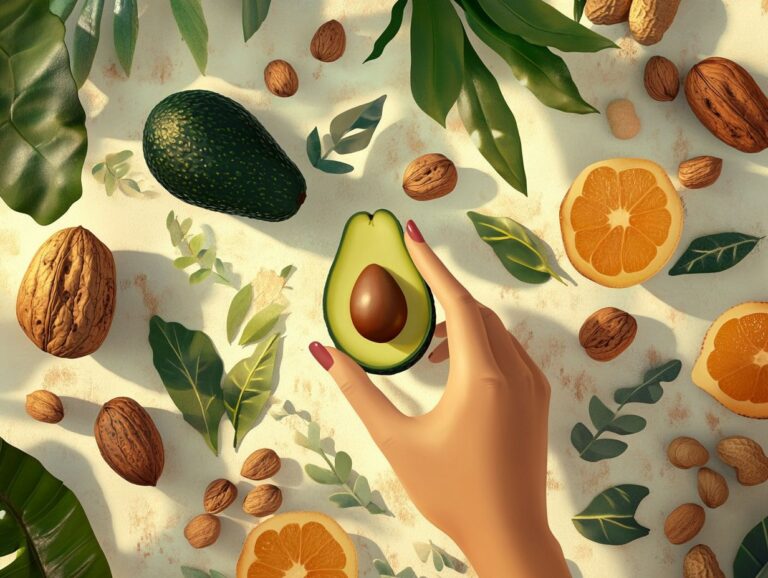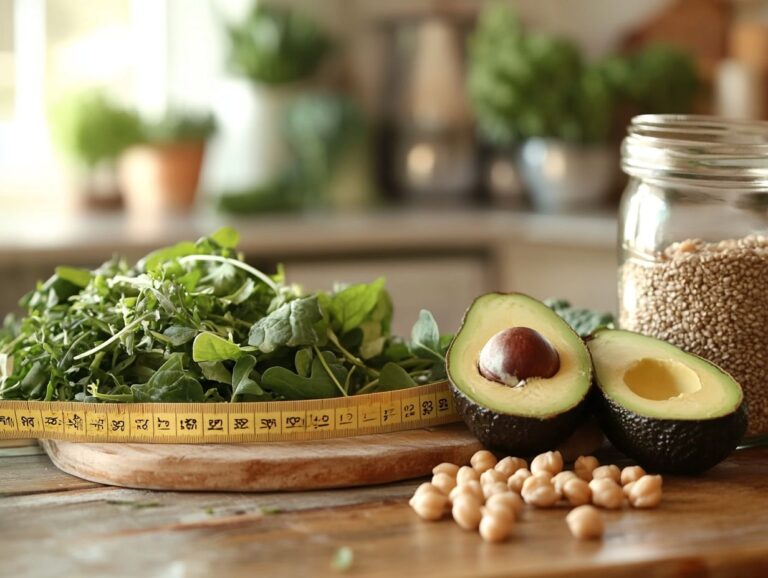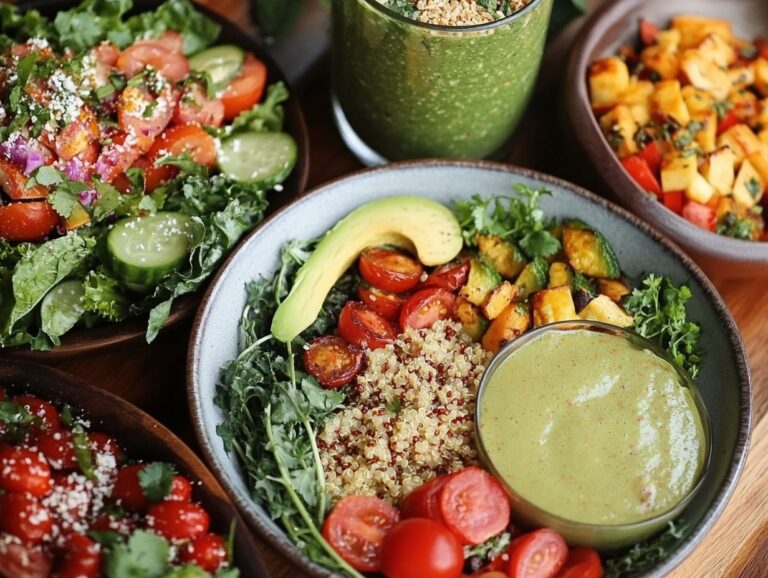A high-fiber vegan diet emphasizes the consumption of foods rich in fiber. This article explores the essential role of fiber in promoting a healthy gut and its impact on digestion. It also provides information on the best vegan diets that are high in fiber, the recommended daily fiber intake, and practical tips for incorporating more fiber into your meals. Additionally, potential risks associated with a high-fiber diet are discussed, enabling you to make informed decisions on your journey toward a balanced, fiber-rich vegan lifestyle.
What is a High-Fiber Vegan Diet?
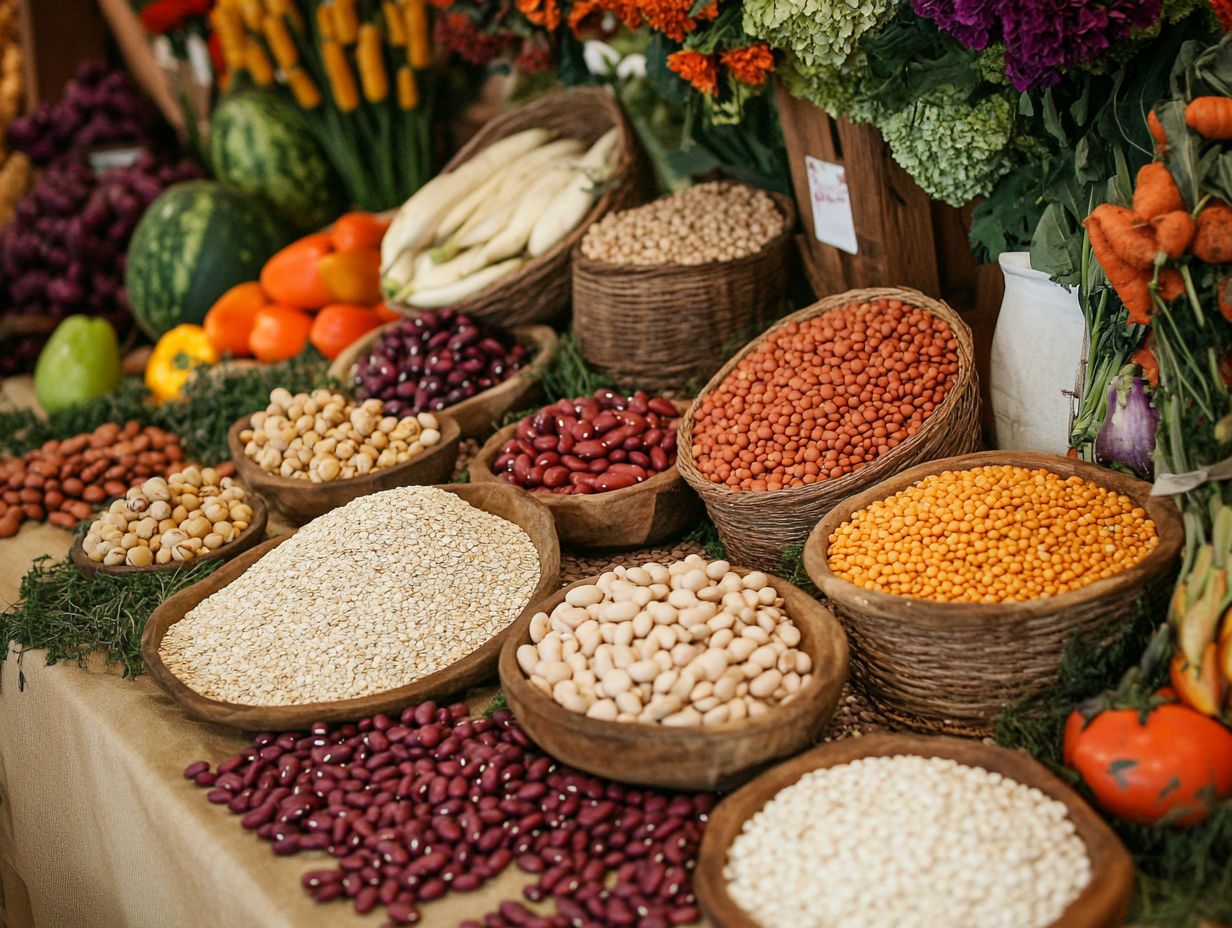
A high-fiber vegan diet focuses on plant-based foods that are rich in dietary fiber and promotes overall health and wellness. This approach is central to a plant-based diet, which emphasizes natural and minimally processed foods.
This type of vegan diet emphasizes the consumption of whole grains, legumes, fruits, and vegetables, offering adequate nutrition while also supporting gut health and the microbiome.
Research has demonstrated that a higher fiber intake is associated with numerous health benefits, including a reduced risk of chronic diseases such as cardiovascular disease, type 2 diabetes, and colorectal cancer. These findings are supported by studies published in the Journal of the National Cancer Institute and the Journal of the Academy of Nutrition and Dietetics.
Why is Fiber Important for a Healthy Gut?
Fiber is a vital component of a healthy diet, particularly for maintaining gut health and supporting a healthy microbiome. Dietary fiber serves as a prebiotic for beneficial gut bacteria, facilitating the production of short-chain fatty acids (SCFAs), such as butyric acid, which are essential for reducing gut inflammation and enhancing the immune system.
Sufficient intake of dietary fiber has been linked to improved bowel movements and a decreased incidence of various gastrointestinal disorders, underscoring its significance in a balanced diet.
What is the Role of Fiber in Digestion?
Dietary fiber plays a crucial role in digestion as a bulking agent. It helps regulate bowel movements, prevents constipation, and is classified into two types: soluble fiber, which dissolves in water and aids in reducing cholesterol levels, and insoluble fiber, which adds bulk to the stool and promotes regular bowel movements. Soluble fiber, found in foods like oats and beans, ferments in the gut to produce short-chain fatty acids like butyric acid, which are beneficial for gut health.
Adequate fiber consumption is essential for optimal digestive health and the proper functioning of the gastrointestinal system. Incorporating a variety of fiber-rich foods, such as fruits, vegetables, whole grains, and legumes, enhances digestive function while supporting the growth of beneficial gut bacteria.
Soluble fiber, found in foods like oats and beans, ferments in the gut to produce short-chain fatty acids that nourish colon cells. In contrast, insoluble fiber, which is prevalent in whole grains and nuts, facilitates the efficient movement of food through the digestive tract.
Maintaining a healthy balance of both types of fiber can help preserve a healthy gut microbiome, thereby reducing the risk of digestive disorders and promoting overall health. This balance is crucial for supporting the immune system and reducing inflammation.
How Does Fiber Benefit Gut Health?
Fiber plays a crucial role in gut health by nourishing the microbiome, which supports the growth of beneficial bacteria that aid in digestion and overall well-being. Consuming an increased amount of fiber has been linked to a reduction in gut inflammation, which is essential for preventing gastrointestinal diseases and supporting a healthy immune system.
The fermentation of fiber in the gut produces short-chain fatty acids, which offer protective effects against colorectal cancer and other disorders. These short-chain fatty acids serve as an energy source for colon cells and help regulate metabolic processes.
Including a wide variety of fiber from fruits, vegetables, legumes, and whole grains can cultivate a diverse microbiome, which is vital for maintaining balance and reducing the risk of chronic diseases.
Additionally, a healthy microbiome has been shown to influence mood and cognition, indicating that the benefits of fiber extend beyond digestive health. Therefore, increasing fiber intake is a simple and effective way to enhance gut health and bolster the body’s defenses against potential diseases. Dr. Jessica Hope from Stanford Lifestyle Medicine emphasizes the importance of fiber in the Gut Health Revolution Course, noting its role in overall wellness.
What Are the Best Sources of Fiber on a Vegan Diet?
The best sources of fiber in a vegan diet come from whole foods, including whole grains, legumes, fruits, and vegetables.
Each of these food groups offers different types of dietary fiber, each with unique health benefits.
- Whole grains, such as oats and brown rice, are rich in soluble fiber, which helps lower cholesterol levels.
- Legumes, including beans and lentils, contain both soluble and insoluble fibers that promote bowel health.
- Additionally, fruits and vegetables provide essential micronutrients alongside fiber, contributing to overall fiber intake and supporting a healthy microbiome.
1. Whole Grains
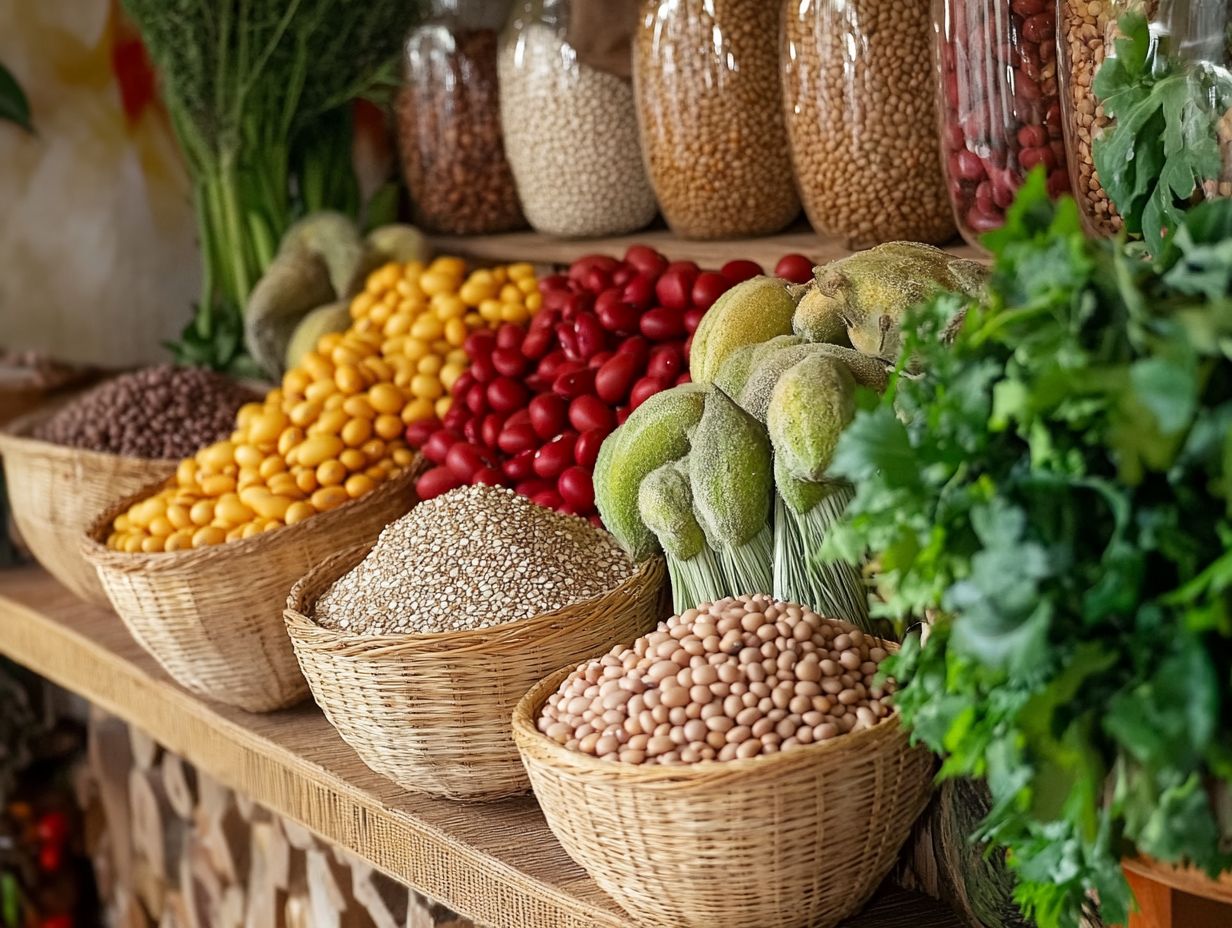
Whole grains are rich in dietary fiber, making them an essential component of a healthy vegan diet centered on plant foods.
Grains such as oats, quinoa, and brown rice offer both soluble and insoluble fiber, which contribute to improved gut health, lower cholesterol levels, and regular bowel movements.
Incorporating a variety of cereals like barley, farro, and bulgur can enhance the nutritional value, flavor, and texture of a vegan diet. These grains not only provide important vitamins, such as B vitamins, but also essential minerals like magnesium and iron, in addition to their fiber content.
The soluble fiber found in oats can help reduce blood cholesterol, while the high fiber content of brown rice promotes satiety, aiding in weight maintenance and loss.
Furthermore, the phytonutrients present in these grains support cardiovascular health.
2. Legumes
Legumes, such as beans, lentils, and chickpeas, are among the richest sources of dietary fiber in a vegan diet. They contain both soluble and insoluble fibers, which help improve gut health, regulate blood sugar levels, and reduce the risk of chronic diseases like type 2 diabetes and cardiovascular disease.
These versatile foods not only support digestive health but also contribute to overall well-being. For instance, black beans are an excellent source of protein, making them an ideal substitute for meat for those looking to reduce their intake of animal products.
Lentils are nutrient-dense and provide a rich supply of folate and potassium, both of which are vital for heart health. Chickpeas offer a unique combination of fiber and protein, helping to create a feeling of fullness, which makes them an excellent choice for weight management.
Additionally, they are economical and easy to prepare, making them a great addition to a daily diet.
3. Fruits and Vegetables
Fruits and vegetables are essential components of a high-fiber vegan diet, offering a diverse range of fiber types and nutritional benefits.
Foods like apples, berries, broccoli, and carrots not only contribute to your daily fiber intake but also provide vitamins, minerals, and antioxidants that support overall health.
Leafy greens such as spinach and kale, along with legumes like lentils and chickpeas, enhance gut health by nurturing a thriving microbiome.
These plant-based staples are rich in both soluble and insoluble fiber, which helps regulate digestion and maintain regular bowel movements.
Incorporating a variety of these fruits and vegetables not only enhances dietary diversity but also supports weight management by promoting feelings of fullness.
Ultimately, including such fiber-rich foods in daily meals allows individuals to enjoy improved digestion and overall vitality.
4. Nuts and Seeds
Nuts and seeds are exceptional sources of dietary fiber, healthy fats, and essential nutrients, making them an important addition to any high-fiber vegan diet.
Almonds, chia seeds, and flaxseeds are particularly notable for their high fiber content, which can improve bowel movements and contribute to overall gut health. Including nuts in your diet can also enhance the nutritional value of meals, offering essential nutrients alongside fiber.
Along with these popular options, walnuts and pumpkin seeds are also rich in fiber and offer the added benefit of antioxidants that may help reduce inflammation and support heart health.
Brazil nuts are a great source of selenium, a mineral that is vital for maintaining a healthy immune system, while sunflower seeds provide an abundance of vitamin E, which promotes skin health.
Incorporating a variety of these nuts and seeds not only boosts fiber intake but also ensures a diverse range of nutrients that can enhance overall wellness and support long-term health goals.
How Much Fiber Should You Aim for on a High-Fiber Vegan Diet?
The health benefits of a high-fiber vegan diet can be fully realized when individuals meet the recommended daily intake of fiber. According to the Institute of Medicine, these guidelines are essential for maintaining a healthy diet and achieving optimal health outcomes.
According to the Institute of Medicine, adult women should aim for approximately 25 grams of fiber per day, while adult men should target around 38 grams.
These recommended levels can be achieved by including a variety of dietary fiber sources in the diet, such as:
- Whole grains
- Legumes
- Fruits
- Vegetables
1. Recommended Daily Intake
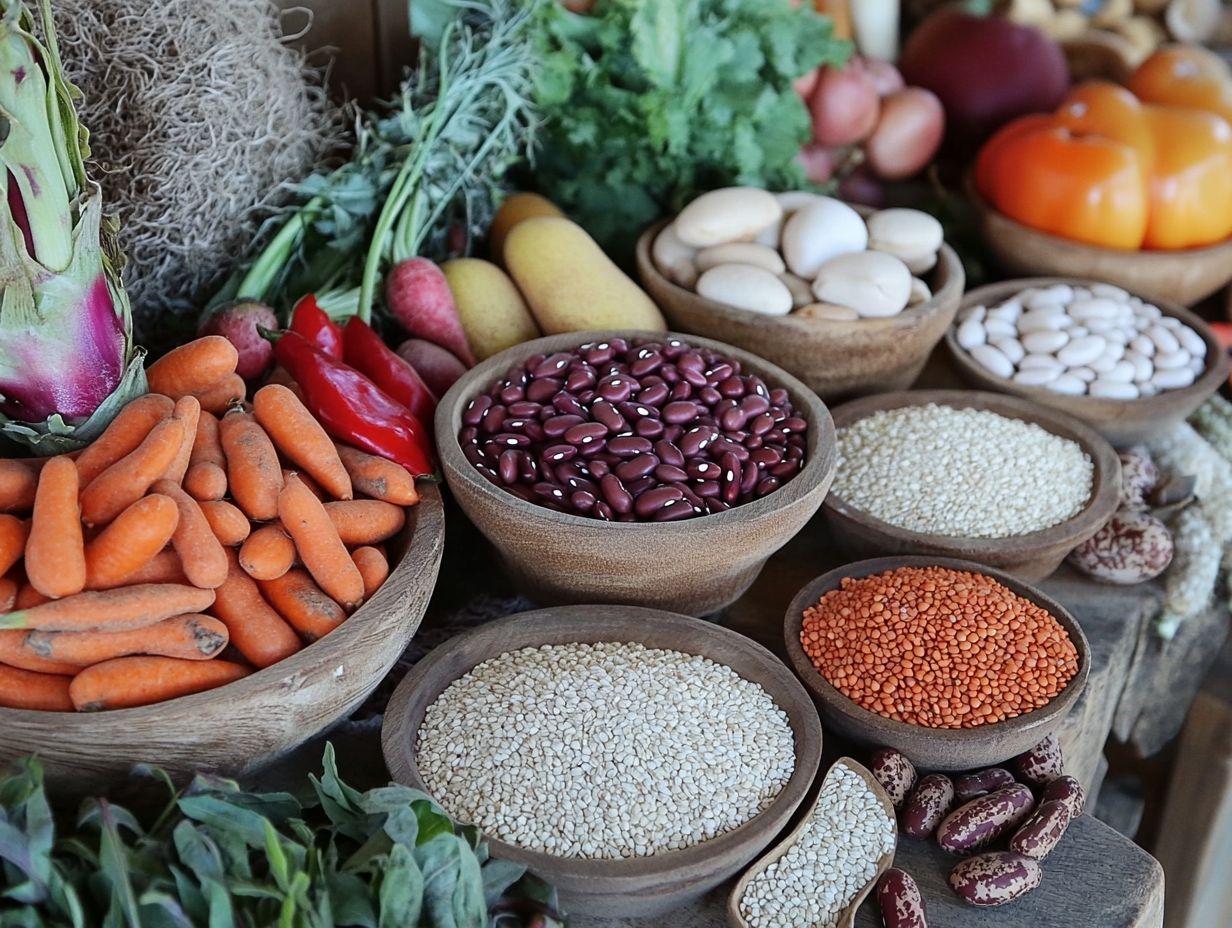
The recommended daily intake of dietary fiber varies by age and gender. For adult women, the recommendation is approximately 25 grams per day, while men should aim for around 38 grams.
Consuming the appropriate amount of fiber not only improves gut health but also lowers the risk of chronic diseases. Additionally, it is important to address fiber intake recommendations for children and older adults.
- Younger children aged 1 to 3 years are advised to consume about 19 grams daily.
- Children aged 4 to 8 years should intake no less than 25 grams.
As children grow older, the requirements increase to 26 grams per day for girls aged 9 to 18 and 31 grams per day for boys in the same age range. Ensuring adequate fiber intake during these years supports gut health and overall well-being.
For older adults, particularly those over 50 years of age, the recommended minimum is 21 grams for women and 30 grams for men. Adequate fiber intake helps maintain regular bowel movements and can reduce the risk of cardiovascular disease and type 2 diabetes.
Incorporating whole grains, fruits, vegetables, legumes, and nuts into their daily diets can help individuals meet these fiber requirements, making digestive health and a healthy microbiome important considerations for people of all ages.
2. Tips for Increasing Fiber Intake
Increasing dietary fiber through simple dietary changes and food choices is a key strategy for improving overall health. However, the most effective way to boost fiber intake at the population level is to ensure that people actually consume more fiber-rich foods and that these products are affordable. This can be achieved through broad public health campaigns and subsidies to make healthy foods cheaper and more widely accessible. Fiber not only supports digestive health but also offers numerous health benefits, including improved cholesterol levels and reduced inflammation.
For individuals, here are some straightforward and effective strategies to enhance fiber intake:
- Whole Grains: Increase the consumption of foods containing whole grains, such as whole-grain bread, whole-grain cereals, brown rice, quinoa, bulgur, barley, and oats.
- Beans and Legumes: Incorporate beans, lentils, peas, and chickpeas into meals more frequently, as they are excellent sources of natural fiber.
- Fruits: Regularly consume fresh fruits, especially those with edible skins (like apples, pears, and grapes), fruits with high water content (such as berries, cherry tomatoes, watermelon, and oranges), and dried fruits (like prunes and figs) to improve fiber intake. Fruits are also rich in essential nutrients and antioxidants that support the immune system.
- Vegetables: Include leafy green vegetables (such as raw spinach, kale, and arugula), root vegetables (like carrots, sweet potatoes, and potatoes), and starchy vegetables (such as corn and peas) in your diet to boost fiber consumption.
- Allergy and Intolerance Considerations: If an individual has an allergy or intolerance to a specific food, they can substitute similar foods that provide the same type of fiber. For instance, if someone is allergic to wheat, they can obtain soluble fiber from grains like oats, barley, or rye.
- Cooking Strategies for Better Fiber Intake: The way foods are prepared can enhance fiber consumption:
- Beans, Peas, and Lentils: Soak them for at least 8 hours or overnight to reduce cooking time and improve digestibility.
- Whole Grains: Cook them until soft yet chewy, avoiding overcooking.
- Vegetables: Try to avoid peeling vegetables; if peeling is necessary, save the skins for soups or gravies to prevent wasting fiber.
- Cooking with Skins: Whenever possible, consume starchy vegetables like potatoes, green peas, and corn with their skins.
- Foods Rich in Fiber: Below are examples of high-fiber foods, noting that the fiber content can vary based on cooking or processing methods:
| Food Item | Serving Size | Soluble Fiber (grams) | Insoluble Fiber (grams) | Total Fiber (grams) |
|---|---|---|---|---|
| Whole Grains | ||||
| Brown Rice | 1 cup cooked | 0.7 | 1.6 | 2.3 |
| Barley | 1 cup cooked | 1.2 | 4.1 | 5.3 |
| Oatmeal | 1 cup cooked | 1.4 | 1.1 | 2.5 |
| Whole Wheat Bread | 1 slice | 0.3 | 1.4 | 1.7 |
| Fruits | ||||
| Guava | 1 fruit | 2.7 | 1.5 | 4.2 |
| Raspberries | 1 cup | 1.5 | 1.1 | 2.6 |
| Avocado | 1 medium | 3.4 | 4.6 | 8.0 |
| Bananas | 1 medium | 0.2 | 1.4 | 1.6 |
| Vegetables | ||||
| Potato | 1 medium with skin | 0.9 | 2.3 | 3.2 |
| Sweet Potato | 1 medium with skin | 0.8 | 3.8 | 4.6 |
| Carrots | 1 medium | 0.5 | 1.8 | 2.3 |
| Leafy Greens | 1 cup raw | 0.2 | 1.4 | 1.6 |
| Legumes | ||||
| Lentils | 1 cup cooked | 0.6 | 3.6 | 4.2 |
| Chickpeas | 1 cup cooked | 1.5 | 4.5 | 6.0 |
| Black Beans | 1 cup cooked | 1.4 | 4.1 | 5.5 |
| Kidney Beans | 1 cup cooked | 1.6 | 4.7 | 6.3 |
| Nuts and Seeds | ||||
| Almonds | 1 ounce | 1.0 | 2.7 | 3.7 |
| Chia Seeds | 1 ounce | 5.5 | 8.0 | 13.5 |
| Flaxseeds | 1 ounce | 7.3 | 8.4 | 15.7 |
By implementing these strategies and making informed food choices, individuals can effectively increase their fiber intake and improve their overall health.
What Are the Potential Risks of a High-Fiber Vegan Diet?
While a high-fiber vegan diet offers numerous benefits, it also comes with potential risks that individuals should be mindful of.
These risks include digestive issues such as bloating, gas, and constipation, as well as the possibility of nutrient deficiencies if a balanced diet is not maintained.
1. Digestive Issues
Digestive issues are a common side effect of high-fiber diets, particularly when the increase in fiber intake occurs too rapidly. Symptoms such as bloating, gas, and abdominal discomfort may arise as the gut adjusts to higher levels of dietary fiber, especially if soluble and insoluble fibers are not consumed in appropriate proportions.
To alleviate these uncomfortable side effects, individuals considering a high-fiber diet should gradually increase their fiber intake over several days or weeks. This gradual approach allows the digestive system to adapt without becoming overwhelmed and helps maintain gut health and a balanced microbiome.
Incorporating a variety of fiber sources, such as fruits, vegetables, whole grains, and legumes, will help ensure that both soluble fiber and insoluble fiber are included in the right proportions. Additionally, staying well-hydrated is crucial, as drinking plenty of water can aid digestion and ease some of the discomfort associated with a high-fiber diet.
2. Nutrient Deficiencies
A high-fiber vegan diet carries the risk of nutrient deficiencies if individuals do not ensure they consume a balanced diet that includes all essential nutrients. While foods high in fiber are often nutritious, they may lack certain vitamins and minerals, such as Vitamin B12, iron, and omega-3 fatty acids, which must be obtained from other sources.
To avoid nutrient deficiencies, those following a high-fiber vegan diet should actively include alternative sources of these nutrients in their meals. For instance, Vitamin B12 can be obtained through fortified foods or supplements, while iron can be sourced from legumes, tofu, and dark leafy green vegetables, especially when paired with foods high in vitamin C to enhance absorption. Additionally, consuming a variety of plant-based foods ensures a balanced intake of essential nutrients.
Additionally, incorporating sources of omega-3 fatty acids, such as flaxseeds and chia seeds, can be beneficial. With careful planning and awareness, individuals can ensure that their high-fiber vegan diet remains nutritionally complete and does not lead to deficiencies.
3. Interference with Medications
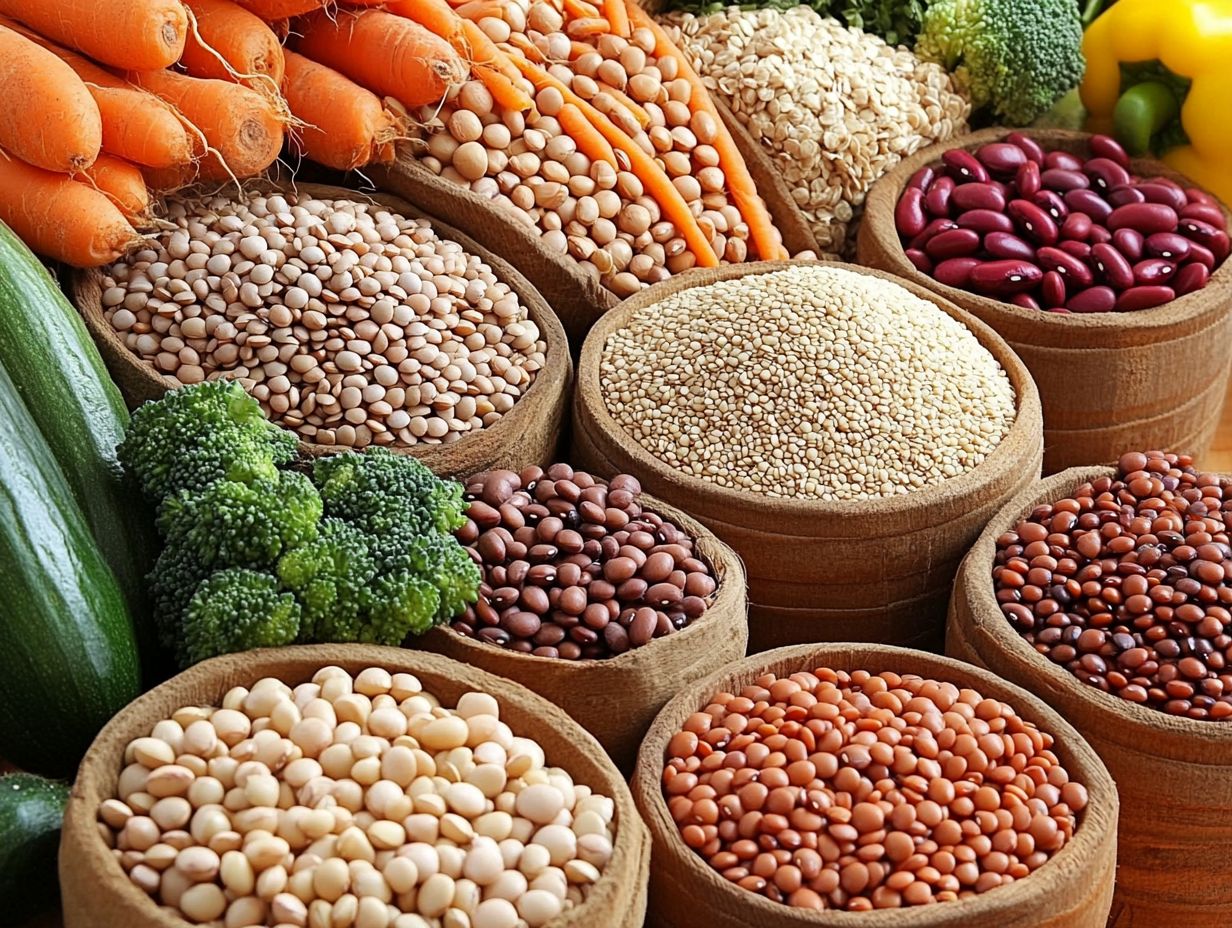
A high-fiber diet can influence the effectiveness of certain medications, as dietary fiber may interfere with medication absorption. Some types of dietary fiber can bind with specific medications, reducing the amount of the drug that enters the body.
Therefore, it’s important to consult a healthcare professional regarding the timing and dosage of medications if you are consuming a high-fiber diet. Additionally, a balanced approach to fiber intake can help ensure that nutrient absorption is not compromised. Eating a variety of soluble fiber and insoluble fiber sources can support different aspects of digestive health.
While dietary fiber is essential for digestive health and can help lower cholesterol levels, regulate blood sugar, and reduce the risk of colorectal cancer, it is crucial to time meals and medications appropriately. For medications that require precise absorption, it may be beneficial to space fiber-rich meals and medications apart by at least two hours.
This separation allows the body to fully absorb the medication before fiber interacts with it. Furthermore, the type of fiber consumed is significant, as soluble fiber can affect absorption differently than insoluble fiber. Being mindful of this can help manage overall health while also supporting medication efficacy. The Institute of Medicine provides guidelines to ensure adequate fiber intake for different age groups and genders.
How to Incorporate a High-Fiber Vegan Diet into Your Lifestyle?
Incorporating a high-fiber vegan diet into your daily life can be a positive and rewarding journey. With awareness and careful planning, including high-fiber options in a vegan diet is quite manageable.
Simple strategies such as meal prepping, snacking on high-fiber foods, and exploring new recipes can significantly boost the fiber content of your meals.
1. Meal Planning
Meal planning is key to ensuring a balanced and nutritious diet, particularly for those following a plant-based diet. Plan meals ahead to include a variety of whole grains, legumes, fruits, and vegetables to meet your fiber needs.
Meal planning is a crucial factor in successfully transitioning to a high-fiber vegan diet, as it enables individuals to structure their meals around foods rich in fiber. By preparing a variety of recipes that incorporate whole grains, legumes, fruits, and vegetables, individuals can ensure they receive an adequate amount of fiber while also enjoying a diverse and nutritious diet.
This organized approach not only simplifies grocery shopping but also promotes mindful eating habits, which can lead to better health outcomes.
Key ingredients for a high-fiber vegan diet include:
- Quinoa
- Lentils
- Chia seeds
along with a wide range of vegetables. When creating a weekly menu with sufficient fiber content, dishes such as hearty black bean chili or refreshing quinoa salad packed with colorful produce can be included.
Additionally, snacks like hummus with carrot sticks or apple slices with almond butter can help maintain fiber levels throughout the day, further highlighting the importance of meal planning in supporting high-fiber vegan diets.
2. Gradual Increase in Fiber Intake
Gradually increasing fiber intake is essential for preventing digestive issues and allowing the gut to adapt effectively. Instead of making drastic changes to your diet, slowly incorporating fiber-rich foods can help reduce discomfort and optimize digestive function.
To implement this gradual approach, start by adding small amounts of high-fiber fruits, vegetables, whole grains, and legumes to your meals. Monitoring your digestive reactions is crucial, so keeping a food diary may assist in identifying which foods might cause discomfort or bloating.
It is also important to maintain a balance between soluble and insoluble fibers, as each type offers distinct health benefits.
- Soluble fibers, found in foods such as oats and beans, help manage cholesterol levels.
- Insoluble fibers from whole wheat grains and nuts promote regularity.
This intentional approach will enhance not only digestive function but also overall health.
3. Finding High-Fiber Vegan Recipes
High-fiber vegan recipes enable individuals to prepare delicious and nutritious meals as part of a high-fiber diet. Whole grains, legumes, fruits, and vegetables are excellent sources of dietary fiber, and numerous cookbooks and online recipe platforms provide valuable ideas for achieving fiber intake goals.
Culinary blogs and popular recipe-sharing websites showcase thousands of recipes from around the world, allowing for the exploration of a diverse array of dishes and ingredients. The flavor of high-fiber vegan recipes is enhanced by incorporating a wide variety of ingredients.
For instance, a high-fiber dish could consist of:
- a quinoa salad with black beans, corn, and chopped bell peppers
- a lentil stew with spinach and sweet potatoes
The components of these high-fiber vegan recipes are packed with nutrients, resulting in dishes that are both filling and wholesome. These recipes contribute to improved digestive health and help maintain a healthy weight.
